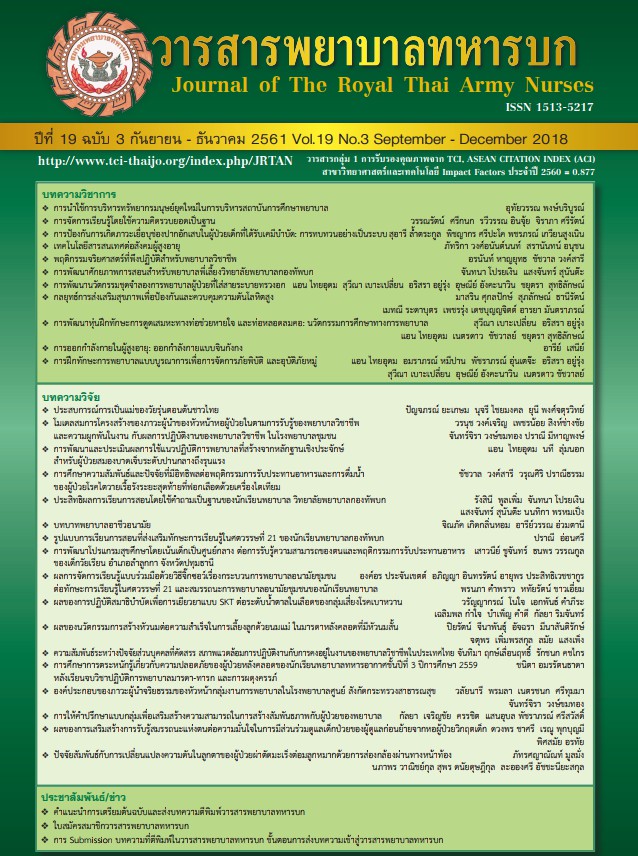The study of awareness of the 3rd Year Royal Thai Air Force Student Nurses in the academic Year 2016 about the patients’ safety during puerperium after finishing Maternal-Newborn Nursing and Midwifery Practicum 3
Keywords:
awareness, patient safety, R.T.A.F. Student NursesAbstract
This descriptive research proposed to study awareness of the 3rd Year R.T.A.F. Student Nurses in the academic Year 2016 about the patients’ safety during puerperium after finishing Maternal-Newborn Nursing and Midwifery Practicum 3. Sample size is 46. After watching researcher’s video about patient safety indicators: infection control & clean care, medication safety, patient care safety, line, tube and catheter, and emergency response, the 46 samples wrote about the awareness of patient safety indicators in the answer sheet. Content analysis shows: 1. Lack of awareness in immediately sanitizing one’s hands after removing gloves that had an exposure to body fluids. 2. Lack of awareness about risk of venous thrombosis from combined hormone drug in the puerperium period. Most sample didn’t even mention the usage of high alert drugs, only one person did and she mention the about often double checking it before usage when the recommendation would be to double check every time. 3. Having awareness to communicate all required information to professional team and yet, due to loss of SBAR model. No content about preventing uterine inversion before changing from lying to upward position during the move from the stretcher to the bed. 4. Having awareness to take good care of patients in urine catheter and protection IV line from superficial thrombophlebitis. 5. Having awareness to respond in an emergency relating to bleeding but the response is not done in a complete manner.
Downloads
References
2. Supchutikul A. Patient Safety Goals: SIMPLE. Nonthaburi: Healthcare Accreditation Institute (Public Organization); 2008. (In THAI)
3. Somcharoen N. Patient Safety Curriculum Guide Multi- Professional (WHO) : Learning Integration for the 21st Century Bachelor’s Degree Nursing
Curriculum. Journal of The Royal Thai Army Nurses. 2015; Volume 16: 1-7. (In THAI)
4. Bloom, B.S. Taxonomy of education objective: The classification of education goals: Handbook II: Affective domain. New York; David Mckay; 1964
5. Good’s Dictionary of Education.3rded. New York: Mc Graw-Hill Book; 1973. p.54, 129.
6. Breckler SW. Attitude Structure and Function. Hillsdale, NJ: L. Erlbaum Association; 1986.
7. Engle J.F., Kollat D.T., Backwell R.D. Consumer behavior. New York: Holt, Rinehart and Winston; 1968. p. 34-35
8. McIntyre H, Raw A, Stephenson J, Bradley A, Dawson J, Fay M, et al. NICE quality standard 61: Infection prevention and control. National Institute for Health and Care Excellence; 2014.
9. Kaur P, Thaukur R, Kaur S, Bhalla A. Assessment of risk factors of phlebitis amongst intravenous cannulated patients. Nursing and Midwifery Research Journal 2011; 7(3):106-14.
10. Chaleoykitti S, Kamprow P, Promdet S. Patient Safety and Quality of Nursing Service. Journal of The Royal Thai Army Nurses. 2014; Volume 15: 66-70. (In THAI)
11. Nitayangkul S, Nursing Standard for Patient during Crisis. In: Jirasinthipok T. editor. Nursing Standard in Hospital (2ndupdate). 3rded. Bangkok: Nursing division, Ministry of Public Health; 2008 : 187-217 (in Thai)
Downloads
Published
How to Cite
Issue
Section
License
บทความหรือข้อคิดเห็นใดใดที่ปรากฏในวารสารพยาบาลทหารบกเป็นวรรณกรรมของผู้เขียน ซึ่งบรรณาธิการหรือสมาคมพยาบาลทหารบก ไม่จำเป็นต้องเห็นด้วย
บทความที่ได้รับการตีพิมพ์เป็นลิขสิทธิ์ของวารสารพยาบาลทหารบก
The ideas and opinions expressed in the Journal of The Royal Thai Army Nurses are those of the authors and not necessarily those
of the editor or Royal Thai Army Nurses Association.






